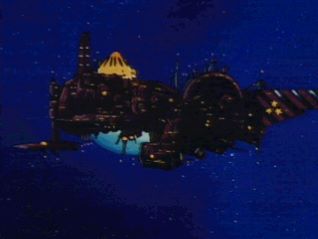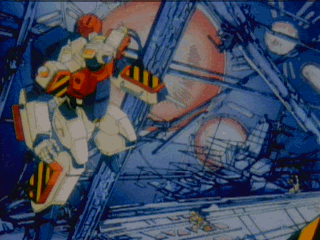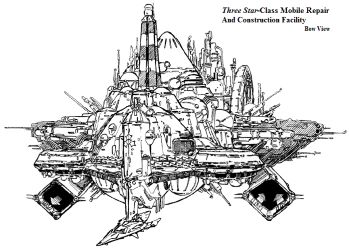 | Factory Ship. |  | ||||
|---|---|---|---|---|---|---|
Maintenance and repair is a major problem facing all UEG long range colony missions. Typical colony missions are expected to last anywhere from 10 to 100 years, however the expected endurance of even the New Macross-Class colony ships without refits is only 20 to 30 years. Carrying a large enough supply of spare parts for all Mecha and starships in a colony mission was
As the name implies the Three Star-Class Facilities are floating factories in space. The lower levels of the ship contain a complete refinery that can extract all necessary metals and raw materials from space debris such as asteroids and comets. These materials are then raised to the core of the starship, which contains a complete manufacturing facility based on technology recovered from the Protoculture factory satellite captured by the UN Spacy in October 2011. The automated factory can manufacture almost any component, from miniaturized microchips to complete Mecha. The factory can even manufacture from scratch capital starships such as a NEW MACROSS-Class Battle Carrier. However this process can take months depending on the complexity of the starship (a NEW MACROSS-Class battle carrier will take almost a year to build from scratch while utilizing the complete resources of the platform during that time). The Three Star-Class facility is of course capable of conducting routine repair and maintenance on starships as well to prolong their active lifespan. A large beam is mounted from the rear of the ship which serves as a drydock for starship repair, refit, and construction. The Three Star-Class Facilities are also capable of developing new products and weapons. The crew complement of the ship includes a trained engineering staff of over 1,000 along with the most advanced CADAM (computer-aided design and manufacturing) systems available to the UGC. In addition Three Star-Class Facilities maintain constant contact with other colony missions as well as UGC headquarters via the Galaxy Network communications net, allowing new designs to be quickly disseminated across the UN Spacy fleet as they are developed. This permits even the most distant colony missions to keep their equipment and Mecha up to date with the latest technology available. The largest drawback to the Three Star-Class platforms is their limited defensive capabilities. Unlike other UGC colony ships they can only mate with a single BOLOGNESE-Class stealth frigate for protection. For this reason Three Stars are always escorted by a small fleet of BOLOGNESE-Class to protect them against attack. Three Star-Class vsls have become a critical part of the UGC colonization strategy, and every colony mission for the past 25 years has included 1 to 4 manufacturing platforms as part of their fleet. The Three Star-Class has lost much of its shine as a result mostly of expansion; New designs come along that the Three Stars can't accommodate, and new factory ship designs come along that out class them. While the fleet is long from being retired, the UGC is searching about for a possible successor. Government: United Galaxies Council. Ship Type: Long Distance Factory Ship. Class: Three Star-Class. Crew (not including Stealth Frigate): 233,000 total. Military Crew: 5,000. Civilian Crew: 50,000. Police/Civil Defense: 3,000. Permanent Civilian Populace: 175,000 MDC By Location: | ||||||
| * Hull Rear Boom/Drydock Section ** Command Tower/Communications Center middle) Connection Joint/Engineering Section Forward Refining Scoops (2) *** Main Engines/Power Plant (2) | 100,000 60,000 5,000 | *** Auxiliary Engines (4) Small Airlocks/Access Hatches (150) Main Airlocks (4) Outer Hull (per 40ft area) Interior walls (per 20 feet) **** Pin Point Barriers (4) | 250 each 800 120 20 5,000 each | |||
| Notes: * Depleting the MDC of the main body will essentially destroy the facility. All internal systems will shut down, including life support and internal gravity. The factory ship itself will be an unsalvageable floating wreck, and any surviving colonists must be rescued quickly or will die from asphyxiation as the remaining atmosphere drains into space. In addition, there is a 60% chance that the entire Three Star-Class will explode due to the volatile chemicals and materials within, doing 1D6 times 1000 MD to everything in a 3 mile (4.8 km) radius from the ship. ** Depleting the MDC of the command tower will kill the bridge crew of the vessel and deprive it of long range/hyperspace communications, radar and subspace sensors. The vessel can be commanded either from an auxiliary bridge near the center of the ship or from the BOLOGNESE-Class Stealth Frigate attached to the platform. *** Depleting the MDC of the main engines will force the ship to rely on its auxiliary engines. Depleting the MDC of the main engines AND auxiliary engines will leave the factory ship adrift in space. If in an atmosphere, the colony will crash (destruction of the main engines will render the antigravity system useless due to loss of power). **** The Pinpoint Barriers regenerate at a rate of 1,250 MD per second (2,500 MD per melee round). If destroyed, a barrier will completely regenerate within four seconds (2 melee rounds). See the Pinpoint Barrier System entry for details. Speed and Statistical Data: | ||||||
| Speed (sublight): 0.16 speed of light (25,600 miles per second). Speed (Auxiliary Drives): Mach 3. Space Fold Range: Unlimited (1 light year every 6 minutes). Planet bound: Designed to land in a planetary ocean when necessary but not designed to maneuver in an atmosphere. Three Star-Class vessels are NOT designed to land on the ground. If they do so the landing will inflict 3D6 times 1000 MD damage to the main body of the spacecraft (any ships docked to her will also suffer total destruction unless it detaches prior to crashing) unless proper preparation is made in advance (a spacefield). Maximum Range: Unlimited (estimated 30 year life span). Length (main body, excluding boom): 6,560 ft (2,000 m). | Height (main body): 4,100 ft (1,250 m). Length (rear boom/drydock): 18,700 ft (5,700 m). Weight: Approximately 210,000,000 tons (empty). Power System: ORTEC/General Galaxy Main Reactor. Fold System: ORTEC/Shinnakasu/General Galaxy Advanced Fold System Cluster. Sublight Drive: ORTEC/Centinel Impulse Drive Cluster. Gravity Control System: Internal. Auxiliary Engines: Shinnakasu/Shinsei Industries/Agar Nuclear Pulse Rocket Motor Clusters. Cost and Availability: 100 BILLION to build; Takes up to 5 YEARS to complete one. | |||||
| Weapons Systems: | ||||||
| 1. Pinpoint Barrier Defense System: Originally developed by researchers onboard the SDF-01 MACROSS during the First Robotech War, the Pinpoint Barrier System is a standard defense system on board all UN Spacy starships and colony vessels, including the Three Star-Class ships. The system generates four small disc-shaped force fields that can be positioned anywhere along the ship to deflect missiles, energy beams or projectiles. Each pinpoint barrier is about 200 ft (61 m) in length and can absorb up to 5,000 MD in damage, which then regenerates within four seconds (2 melee rounds). The barriers can also be layered on top of each other to generate a field which provides 20,000 MDC and can even deflect heavy particle beams (usually). The four barriers are controlled by operators in the command tower of the carrier. These operators are instructed to defend (1) any breaks or weaknesses in the main hull, (2) the main and auxiliary engines, (3) the engineering section/stealth frigate docking section and (4) any starships under construction, in that order. The operators primarily concentrate on defending the ship against larger spacecraft and leave defense against attacking Mecha to the VF pilots from the stealth frigate. MDC: Can sustain up to 5,000 MD per round. Regenerates at a rate of 2,500 MD per melee round. Range: Up to 300 feet (91.5 m) from the surface of the vessel. Radius: 200 ft (61 m). Attacks Per Melee: Can move from one end of the vessel to the other in less than a single round. Trained operators can attempt to block attacks up to 8 times per melee (counts as a parry) and are at +7 to block. Untrained characters can parry up to their number of hand-to-hand attacks with their normal parry bonuses only. Payload: Nearly inexhaustible. Will work as long as system is functional (see below) and engines are intact. If main engines are destroyed, the barrier will loose power and not function. NOTE: If all four barriers are grouped in a single spot they can deflect a heavy particle beam attack, such as the one generated by the Macross Cannon, T'entraedi command warships, and the like. However, the beam will completely destroy all four barriers and put incredible strain on the pinpoint barrier system, to the point where it may short out. After deflecting an energy beam, roll percentile dice on the table below to determine additional effects/damage. 01-15: Lucked out, system will be operational in 1D6 hours. 16-30: Minor damage, system will require 4D6 hours to repair. 31-45: Major damage, system will require 2D6 times 10 hours to repair (yes, DAYS of work). 46-60: Completely destroyed! System can be rebuilt, but will require new parts and 2D6 DAYS of work to replace. 61-75: Major damage, system will require 2D6 times 10 hours to repair. 76-90: Minor damage, system will require 4D6 hours to repair. 91-95: Lucked out, system will be operational in 1D6 hours. 96-00: It's a miracle! Trivial damage only, system will be operational again in only 4D6 melee rounds! | 2. Defensive Laser Batteries (0): Each vessel has 20 defensive laser batteries for anti-missile and meteorite defense. MD: 5D6 per blast. Rate of Fire: Per gunners attacks per melee plus bonuses (generally 4 or 5 per melee). Range: 500 feet. Payload: Unlimited. 3. Automated Missile Battery (02): 02 of these batteries are on each vessel, on dorsal and one ventral. Missile Type: Any MRM or LRM Purpose: Anti-Ship Defense. MD and Range: Varies by type used. Rate of Fire: Twice per melee. Payload: Up to 1,000. 4. Standard Mecha Complement: The landing bays in Three Star-Class vsls have enough room and resources to adequately support up to 4 squadrons (48 fighters) of VFs if necessary. | |||||
 A Three Star-Class Factory Ship Underway. | ||||||
 Construction Capabilities: Construction Capabilities:As stated above, the main purpose of the Three Star manufacturing platforms is to produce all parts, supplies, and materials the colony mission needs to operate. In general it can be assumed that Three Star ships are constantly busy around the clock producing a wide range of standard products. However there are times when the GM will need to know approximately how long it takes a Three Star-Class facility to manufacture critical pieces of equipment (usually military in nature, such as Mecha and starships). The numbers below are intended to give the GM a rough estimate of how fast construction takes place aboard the Three Star-. For each entry two values are listed. The first is the amount of time it takes the automated factories aboard the vessel to produce the item from scratch, and the second lists how many can be produced in a given period of time. The factory aboard the Three Star-Class operates in an assembly line fashion so that multiple items can be constructed at the same time. This data assumes that the Three Star-Class has an ample supply of asteroids and space debris available to it for raw materials. These figures should be used for approximation only; GMs, feel free to change these values as you require. | ||||||
| Standard UGC Combat Gear (Flight Suit plus Sidearm) | ||||||
| Standard Veritech Fighter (e.g. VF-01 Super Veritech) | ||||||
| Advanced Veritech Fighter (e.g. S/R-2000 Raven Spy Veritech) | ||||||
| Small Starship (Shuttles, Frigates, etc) | ||||||
| Large Starship (e.g. Battleships, Carrier, etc) | ||||||
| SDF/UDF Starship (e.g. EXEDORE FORMO-Class, etc) | ||||||
| Features: | ||||||

